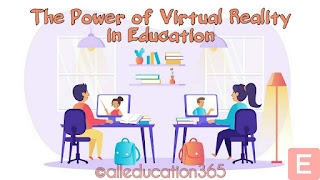The Power of Virtual Reality in Education: Transforming the Way Students Learn
The Power of Virtual Reality in Education
Introduction
Virtual reality technology is revolutionizing the way people learn and experience new things. The education sector is no exception, as it is embracing VR to enhance the learning experience of students.
VR technology provides students with an interactive, immersive and engaging environment that can help them better understand complex subjects and retain information.
This article explores the ways in which VR is transforming education and the benefits it brings to students and teachers.
1. Enhancing the Learning Experience with VR
One of the most significant benefits of VR in education is the ability to create a more engaging and interactive learning environment. In a traditional classroom setting, students often struggle to grasp abstract concepts and ideas, as they are limited to reading textbooks or listening to lectures.
With VR, students can immerse themselves in a virtual environment that helps them understand complex concepts in a more engaging and interactive way. For example, students can take a virtual tour of the human body, where they can interact with and learn about different organs and systems.
They can also visit historical sites, such as ancient civilizations, and interact with objects and characters, which helps them understand history in a more personal way.
2. Improving Retention of Information
Studies have shown that students are more likely to remember information that they have experienced firsthand, rather than information that they have simply read or listened to.
VR provides students with an interactive, hands-on experience that can help them better understand and retain information. This is because VR stimulates multiple senses, such as sight, sound, and touch, which helps students create stronger and more meaningful connections to the material they are learning.
For example, a student who learns about the formation of a volcano through a virtual experience is more likely to remember the information than a student who simply reads about it in a textbook.
3. Access to Hands-On Learning Opportunities
VR technology provides students with access to hands-on learning opportunities that would otherwise be unavailable to them.
For example, students can perform virtual dissections of animals, participate in virtual field trips, or perform virtual experiments. These experiences allow students to interact with the material in a way that is not possible in a traditional classroom setting.
This can be particularly beneficial for students who are interested in fields such as science, technology, engineering, and mathematics, as they can gain hands-on experience and develop practical skills that they can apply in their future careers.
4. Overcoming Limitations of Traditional Classrooms
Traditional classrooms often suffer from a lack of resources, space, and funding, which can limit students' learning opportunities.
VR technology helps to overcome these limitations by providing students with access to a vast array of educational resources and experiences that are not available in traditional classrooms.
For example, students can experience a virtual field trip to a far-off location, such as the Great Barrier Reef, without having to leave the classroom.
They can also interact with virtual objects and simulations that help them better understand complex concepts, such as physics or chemistry.
5. Cost-Effective Alternative to Traditional Classrooms
The cost of traditional classrooms can be prohibitive for many schools and students, particularly for those who live in rural or remote areas.
VR technology provides a cost-effective alternative that can provide students with access to a high-quality education without the need for expensive physical resources. For example, schools can purchase VR equipment and educational content at a lower cost than they would need to invest in physical resources and textbooks.
Additionally, VR provides students with access to a wide range of resources and experiences, which can help to reduce the cost of education over time.
6. Improving Collaboration and Communication Skills
VR technology provides students with opportunities to collaborate and communicate in a virtual environment, which can help to improve their skills in these areas.
For example, students can work together on virtual projects, simulations, and games that require teamwork and communication. These experiences can help students to develop their problem-solving, critical thinking, and collaboration skills, which are essential for success in both their academic and professional lives.
7. Adaptability to Different Learning Styles
Every student has a unique learning style, and VR technology is adaptable to meet the needs of each individual student.
For example, some students may learn best through visual experiences, while others may prefer hands-on activities. VR provides students with a variety of experiences and learning opportunities that can cater to different learning styles.
This can help to engage students who may struggle in a traditional classroom setting and improve their overall learning experience.
8. The Future of Education
The potential of VR technology in education is enormous, and it is only the beginning. In the future, VR technology is likely to become even more advanced, providing students with even more engaging and interactive learning experiences.
Additionally, VR technology is likely to become more accessible, making it possible for more students to benefit from its educational benefits.
As VR technology continues to evolve, it will play an increasingly important role in transforming the way students learn and helping to improve educational outcomes.
Conclusion
In conclusion, VR technology is revolutionizing the way students learn, providing them with a more engaging and interactive educational experience.
With its ability to enhance retention of information, provide access to hands-on learning opportunities, and improve collaboration and communication skills, VR has the potential to transform the future of education.
As VR technology continues to evolve and become more accessible, it will play an increasingly important role in providing students with a high-quality education and helping to improve educational outcomes.
